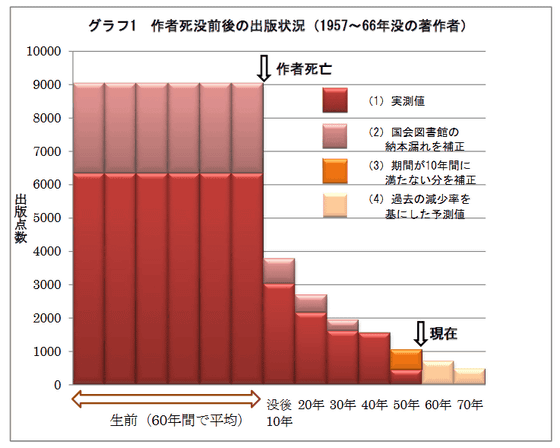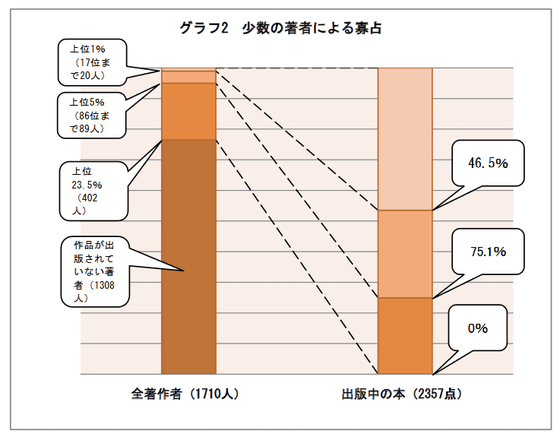A 20-year extension of the copyright protection period is almost determined by the establishment of the TPP-related bill, while enormous data showing that the extension is bad is unveiled

In Japan as of July 2018, the copyright is to be extinguished when fifty years have elapsed since the author died. However, TPP related bill passed by the House of Councilors plenary on 29th June 2018, "Protection period extension of copyright" which has been debated for many years has almost been confirmed. On the other hand, Mr. Yoshikazu Tanji, who opposed the extension of the copyright protection period, has published the data collected until now.
[Repeat] It was an extension of the copyright protection period, and it was only me in Japan that I argued with data. The conclusion the numbers say is "Extension does not promote culture, but rather destroys much." Nevertheless the extension was decided and the data also finished the role. I will release it here as one grave. https://t.co/798acyGM5S
- Tanji Yoshinori aka Morning P (@ tanji_y) July 4, 2018
It is stipulated that the copyright of Japan will last until 'December 31st of the year 50 years since the author died.' For example, for authors whose copyright has disappeared as of January 1, 2018, there are writers such as Shogaro Yamamoto , Sakae Tubai , poet Kubota Kazuho , and Japanese language scholar Tsuyoshi Tokihita .
Published data was published in 2007 by Mr. Tanji on the basis of the National Diet Library Collection Database and the Japan Book Publishing Association database, the status of publication of 3674 copyrighted work died in 1957-1966, before, during and after death · 2007 Surveyed and entered. Based on this data, Mr. Tanji's research report "How to destroy books - the process and mechanisms by which books disappear during the protection period " is published in " Forum to consider the extension problem of copyright protection period ".
(PDF file) How to destroy a book - Process and structure of books disappearing during protection period
http://thinkcopyright.org/tanji-book.pdf
According to data and research reports, Mr. Tanji points out that the author is publishing books after death at 50.1% of the total, and for the remaining 49.9%, the protection period itself does not make sense . Looking at the data, Mr. Tanji insists that the average of the number of publications after death has been decreasing in units of 10 years, and the setting of the copyright protection period can be as long as 50 years. Of course, it is not necessarily the case that books that were out of print due to the disappearance of copyrights will be re-published soon, but with the advent of the Internet, it is also possible to substantially reduce the cost of book-making such as circulation and plate making, It is getting.

As an example, Mr. Tanji lists " a fruit of Olympus " by a reconciliation author, Hideki Tanaka . Although "Olympus fruit" was nearly out of print at that time in 2007, it gained a new reader by being posted in Aozora Bunko after the copyright disappeared, and in 2006 it was on the work page of Aozora Bunko It is said that there were 3835 accesses in one year. According to the Japan Book Publishing Association database, it was said that all works of Tanaka Hideko were out of print at the time of 2007, but after that Tanaka Hideko was reevaluated, and as of July 2018 two new books A work collection is published.
Also, looking at the number of publications after death, we found that 75.1% of the books that were available at the time of 2007 were occupied by the top 5% of books with a large number of publications. In other words, unless it is extremely well-known, publication after death is hopeless, indicating that there is a high possibility of being forgotten.

As a result of discussion proceeding with almost no data as Mr. Tanji indicated, TPP related bills have already been established, TPP 11 will come into effect, and at the same time the extension of the copyright protection period will be enforced even in Japan. Although the copyright protection period extends to 70 years according to Europe and the United States, the reason that the copyright protection term extended to 70 years in Europe and America is the time when the Internet is not used for commercial use Mr. Tanji pointed out that the prerequisites for copyright control are fundamentally different from the modern age where the Internet has already spread.
Related Posts:
in Note, Posted by log1i_yk







